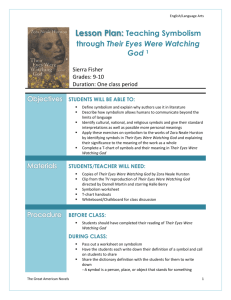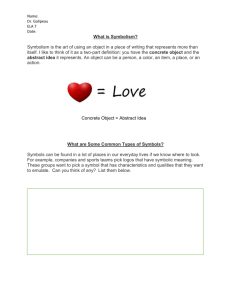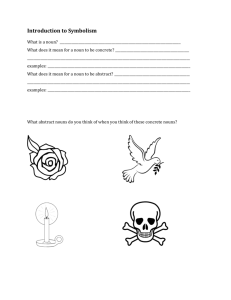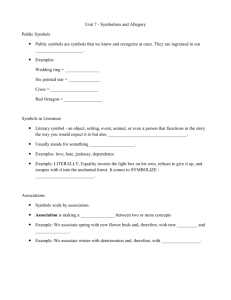Valerie Walsh
advertisement
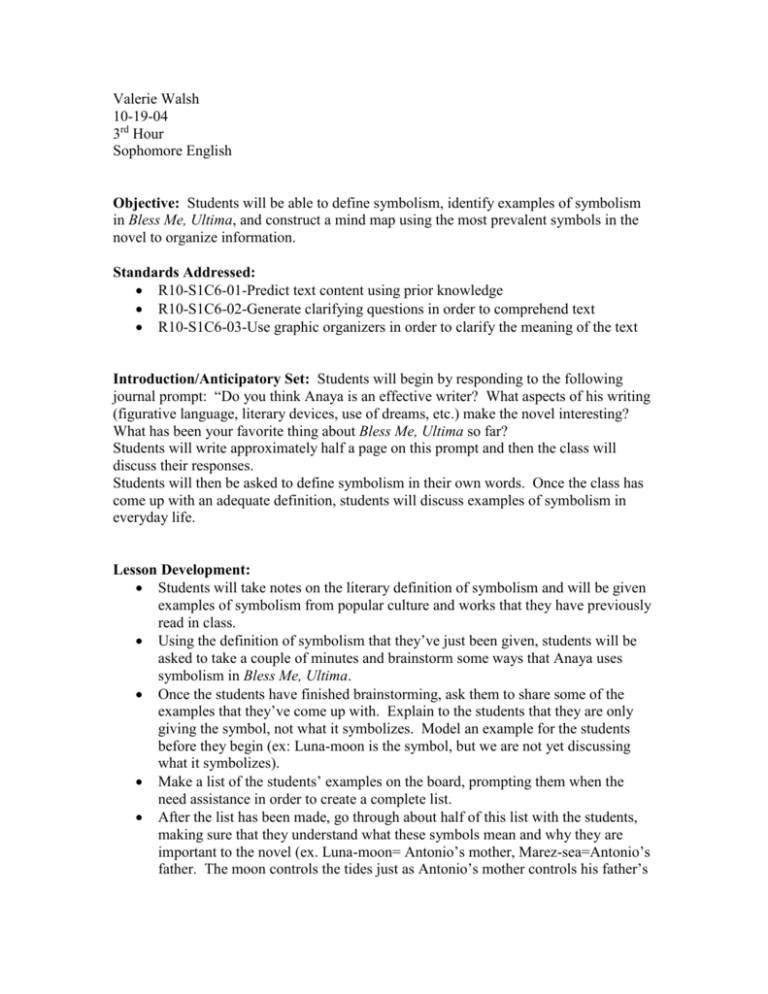
Valerie Walsh 10-19-04 3rd Hour Sophomore English Objective: Students will be able to define symbolism, identify examples of symbolism in Bless Me, Ultima, and construct a mind map using the most prevalent symbols in the novel to organize information. Standards Addressed: R10-S1C6-01-Predict text content using prior knowledge R10-S1C6-02-Generate clarifying questions in order to comprehend text R10-S1C6-03-Use graphic organizers in order to clarify the meaning of the text Introduction/Anticipatory Set: Students will begin by responding to the following journal prompt: “Do you think Anaya is an effective writer? What aspects of his writing (figurative language, literary devices, use of dreams, etc.) make the novel interesting? What has been your favorite thing about Bless Me, Ultima so far? Students will write approximately half a page on this prompt and then the class will discuss their responses. Students will then be asked to define symbolism in their own words. Once the class has come up with an adequate definition, students will discuss examples of symbolism in everyday life. Lesson Development: Students will take notes on the literary definition of symbolism and will be given examples of symbolism from popular culture and works that they have previously read in class. Using the definition of symbolism that they’ve just been given, students will be asked to take a couple of minutes and brainstorm some ways that Anaya uses symbolism in Bless Me, Ultima. Once the students have finished brainstorming, ask them to share some of the examples that they’ve come up with. Explain to the students that they are only giving the symbol, not what it symbolizes. Model an example for the students before they begin (ex: Luna-moon is the symbol, but we are not yet discussing what it symbolizes). Make a list of the students’ examples on the board, prompting them when the need assistance in order to create a complete list. After the list has been made, go through about half of this list with the students, making sure that they understand what these symbols mean and why they are important to the novel (ex. Luna-moon= Antonio’s mother, Marez-sea=Antonio’s father. The moon controls the tides just as Antonio’s mother controls his father’s actions in many ways). Give the students ample opportunity to respond and understand these symbols on their own without too much prompting. After going over about half the list as a class, give the students about 5 minutes to complete the rest of the list on their own and discuss. Explain to the students that since they now have a good understanding of how symbolism works in the novel, they will create a mind map depicting the symbols and what they symbolize. Students may use any illustration that they feel comfortable with or that makes sense to them with respect to these symbols. Next to each symbol, they must write what the symbol means/who or what it represents in the novel. Draw an example on the board for students. Pass out paper to the students and make markers/colored pencils available. Students should work independently. Walk around and assess students’ progress, answering questions. Closure: Have students take out a half sheet of paper and answer the following questions: 1) What is symbolism? 2) Why is symbolism important in the novel? 3) What symbols did you discover were present in the novel that you were not aware of before? Students must answer these questions and pass them up before leaving class. Materials: Overhead notes, paper, markers/colored pencils Luna-moon=Antonio’s mother Marez-sea=Antonio’s father Owl=Ultima Coyote=Tenorio Virgin Mary=all women (forgiving nature) God=all men (holds grudges, angry) Giants=Antonio’s brothers Castle=Antonio’s home River/water=baptism Golden Carp=the way Antonio wants to see God What is symbolism? A symbol is an object, a person, or an event that functions as itself but also stands for something more than itself. The author has a specific intent for each symbol that he or she places in the writing, but the reader may infer different things from these symbols. As you read, you will notice that a symbol may mean something entirely different to you than the person sitting next to you. We must use both the author’s intent and our own imaginations to make these symbols come to life. What are symbols that we see in everyday life? A dove is a symbol of peace Green is a symbol of envy or jealousy A dollar sign is a symbol of money How about symbols that we’ve seen in our reading? Think back to the short story “One Friday Morning”, what did the American Flag represent? The children and the old woman in Nancy Lee’s painting? Now think about “A & P”. What did Sammy’s hitting the No Sale key represent?
